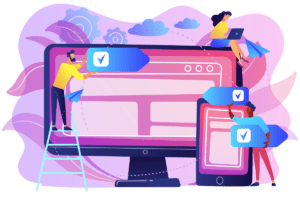The B2B sales environment is a cut-throat world. There are always sales reps fighting over clients to meet quotas and constant outreach strategies to collect all sales available. After all, it’s sales that keep a business afloat. This is why sales can have some of the highest turnovers. As sales reps either can’t hit quotas or quickly realize that this may not be for them. It can be difficult and exhausting to continuously reach out to leads. Then qualify them, turn them into customers and do this not just once but every day and multiple at a time. It’s no mystery why sales are always in demand. It takes a highly motivated individual to perform and excel in this job. Choosing prospecting methods is a crucial part of the sales process and as mentioned above it is both time and effort-intensive.
To the point that this is the part sales reps typically struggle most with. It is no surprise that when you look at B2B sales training guides or blog posts, there is a large focus on this aspect. Hence why we are writing this blog. We will not just rundown some of the best B2B prospecting methods, but also help you understand prospecting methods a bit better so you can develop your own method. So let’s dive into prospecting and see what all the hype is about.
What Is Prospecting?
Sales can be a place with a lot of jargon and it can be difficult to keep up. There are phrases that sales reps constantly pull out in conversation that may make things more confusing. So before we dive into the methods you should use, it is important to nail down the phrase “prospecting”.
B2B prospecting is part of the sales process when you are searching for new clients and customers to add to your funnel and begin nurturing them. The end result you are thriving for is to generate a new business for your company. The immediate goal of prospecting methods is then to find potential clients and move them into your sales funnel to be nurtured. Then if successfully moved through your funnel, they would come out the other end by converting to a paid client.
Prospecting is closely related to lead generation and is commonly said to be two parts of the same process. Although, in prospecting you are generating leads but then go on to qualify them, taking it a step further. This means that you are not simply gathering a list of companies that may be interested, but you are labelling them as someone who meets your buyer persona. You interact with them and help take them closer to becoming paying customers.
The Process of Prospecting
The process of how your prospect may differ from company to company depending on the type of businesses you work with and your industry. In general, the skeleton of the prospecting method will remain the same, but your approach may differ from others.
Researching Leads
Sales reps can locate their own customers and then find out as much as they can about them in order to determine if they are their ideal customer profile. This involves checking that they meet specific criteria that are associated with the company’s buyer persona.
Connection
You then make the first contact with your prospect. In B2B prospecting, this typically involves getting past the “gatekeeper”. The gatekeeper is someone who you have to speak to in order to reach the decision-maker. Typically a receptionist or personal assistant.
Qualification
During your contact with the prospect, the rep will assess their potential and determine if this prospect will make a good candidate. Typically this is done by assessing the prospects’ needs and identifying their pain points. If these needs and pain points line up with your offering and it is something you can solve, they will meet the qualifying standard.
Prospecting Methods
Now that we have gone through what prospecting means and the general framework on how the process works, we can now look at the top prospecting methods. There are many avenues you can explore. You can also have inbound as well as outbound prospecting. Inbound is when you are nurturing a lead that has already shown some interest in your offering. They may have already visited your site, signed up to your email list, or reached out to you. This is the ideal scenario; when your customers come to you and do the qualification process themselves. Outbound is more common and is where the heavy lifting comes in. This is when the sales reps have to do the legwork and find the leads, connect with them, and nurture them from the beginning. This is the type of prospecting we will focus on.
Email Prospecting
Email prospecting is one of the most common forms of prospecting as it has a high ROI (Return On Investment) and a low CPL (Cost Per Lead), as low as $53/lead. The email prospecting realm has plenty of high-quality tools that assist and power its ability to automate, find email addresses, create engaging templates, and more. With these powerful abilities, you now have more time to focus on other channels Emails are also favoured by many businesses as they prefer a visual message they can refer to (compared to cold calls) and it can easily be forwarded down the chain to the decision-maker and other team members for review. Although, it can also be quickly deleted. As previously mentioned, prospecting is not without its challenges.
One way you can reduce the number of sent emails being deleted is through personalization. We have all come across those emails that you never open because of the general greeting of “Dear Sir/Madam”. These bulk sent emails very rarely get past the first obstacle of being clicked on. Through a personalized email, it is much more likely that the recipient will open your email. From there you have to ensure the content is also personalized and engaging to the point they will want to read on. Once they have read your email, it is more likely that they will open dialogue and then you can build a more personal relationship.
Cold Calling
I briefly mentioned cold calling in the method above. There are businesses that do not prefer the outreach methods of cold calling, but there are some that want more of that personal feel of a conversation. There is a common misconception that cold calling does not work anymore. In a recent survey over 40% of salespeople say that the phone is their most effective tool.
For prospecting, speaking on the phone can deliver that personal touch that is often missed in other forms of outreach. It can also offer the ability to field questions and reach decisions more quickly. Instead of going back and forth on emails with questions and concerns over the course of a day (or multiple), this can be handled in a few minutes on the phone.
Cold calling can also be very cost-efficient with the use of modern VOIP (Voice Over IP) phone systems. These tools allow your sales reps to make high-volume calls in a short amount of time and at a lower cost than your typical phone company. If you do plan on using cold calling in your prospecting methods, I don’t recommend reading from a transcript like a robot. Have your talking points in your head and approach the conversation more organically and engage in a natural conversation. Reading from a script makes it sound impersonal. You should make them feel like they are the most important call you’ll make.

LinkedIn is a great way to find your ideal customer profile as you can see their name, the company they work at, job title, groups they are in, etc. It also offers tools that allow you to do in-depth searching of their platform to find the specific types of people you are interested in. Typically on LinkedIn, you have to be a connection or a 2nd/3rd connection of someone in order to view their profile or reach out to them. With their Sales Navigator tools, you are able to see anyone and everyone. However, this does not mean you should jump on LinkedIn and start reaching out to everyone.
Before you start reaching out to others, you need to ensure that your LinkedIn profile is nailed down. No one is going to want to answer you if you have a sloppy or incomplete profile. First, you will want to have a high-quality professionally taken headshot. There is nothing worse than seeing a LinkedIn profile picture where you can see someone’s arm that has been cropped out. Then you want to ensure that you have a killer headline that catches the eye and a short but professional bio. Finally, you will want to make sure that you stay relevant on LinkedIn by posting original content. This way you appear professional and approachable when others see you viewing their profile or reaching out to them.
LinkedIn Reachout
LinkedIn premium is a fantastic tool for those who wish to use LinkedIn for prospecting. There are four options available from LinkedIn when going premium – Career, Business, Sales, and Hiring – and each offers different benefits as you could imagine. For those of you wanting to use LinkedIn as a prospecting method, the sale feature offers improved search features, more InMail messages, a better lead management tool, and other functionality. This will greatly improve your reach out via LinkedIn.
Quora
Quora is a question and answer site and is immensely popular for those who are looking for quick tips and tricks on business and other areas. The way the platform works is simple, users can post questions and others provide answers. You can also search for questions or answers and find related search results.
As a B2B prospecting method, Quora is kind of an inbound and outbound method. As you are able to answer questions that others will see, those users may reach out to you based on your answer. It is good practice to answer questions often that are in your area of expertise and at times plug your business or offering. This way others can see your experience in these topics and reach out for more information.
If you are an active member of Quora and answer various relevant questions, other users will see you as an authority in your field. They will not only trust your answers more but may request answers from you on questions.
Webinars
Webinars are a great way to add qualified leads into your sales funnel, but in order to use them correctly, it does take some time, effort, and experience. You should use your webinars for more than just pitching your offering. A webinar is an opportunity to deliver valuable information and a great way to demonstrate your expertise.
The topics that you cover in your webinars should align with the needs of your customers and answer the questions your ideal customers have. Throughout your webinar, you can drop in details about how your offering can help with their pain points. As long as your attendees gain valuable insight, you do not have to rush them through your funnel. Try to deliver presentations frequently and prospects will come back for each different topic and can be gradually won over to a customer.
Direct Mail
Contrary to popular beliefs, direct mail is not dead. Direct mail just isn’t a prospecting method for everyone, just like cold calling. Direct mail can still be effective, it just heavily depends on your offering and how it is being utilized.
You probably won’t want to get involved with the mailing of leaflets or postcards. Prospecting through direct mail can be useful for customers who still appreciate the personal touch. Mass direct mail campaigns are expensive and should be focused on a handful of customers. Commonly, direct mail is used in prospecting with a handwritten note or letter and is then followed up with a call. If the business you are reaching out to has a high financial value it can be worth it to send a direct mail outreach attempt.
Client Reviews/Referrals
You have worked hard to find qualified leads to make them prospects and then turn them into clients. All of that hard work should not end there, regardless if you are looking for a review/referral. Your clients should be checked on and you should ensure everything is going well. Since you are doing an exceptional job your clients are of course happy with both their experience with you and your offering. Reaching out to them and asking for referrals is a smart form of prospecting. Think of the last time you bought something, did you count on reviews (both the number of reviews and average rating) to make a decision? You are not alone in this.
Your clients will know lots of other people in similar niches that they can recommend to your offering. If your clients are willing to refer you to their contacts, it can make all the difference to your sales. More people will trust an offering that is recommended by someone using the product/service or is more willing to learn.
Either way, through customer reviews or referrals, prospects are more likely to convert to paid customers through these two methods. Timing is key when it comes to reviews/referrals. You don’t want to go back to someone immediately after they have purchased as they may not have had enough time to love the offering. Try to reach out within 14-28 days with your offering. This will allow them enough time to get settled with the offering and still remember their interactions with you.
Wrap Up
There is no way around it. A full pipeline is a key to every business and the only way to achieve this is through sales prospecting. Through using the methods and tips above, you should have a great start to your sales playbook and be able to drastically improve your numbers. It may take some time to discover which of these prospecting methods work best for you and your ideal customer profile. Or maybe there are other prospecting methods that are more attractive to your niche. This is meant to be a guideline to help you and your team navigate through creating your methodology and tailoring it to fit your needs.
 Identify
Identify Personalize
Personalize Benchmark
Benchmark Agencies
Agencies Integrations
Integrations Case Studies
Case Studies Use Cases
Use Cases Blog
Blog Resources
Resources









